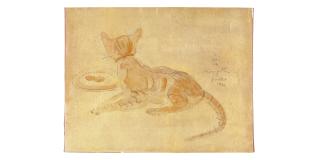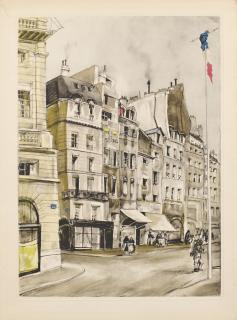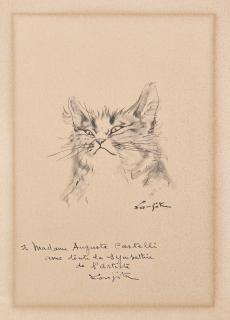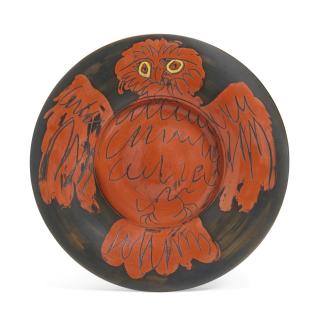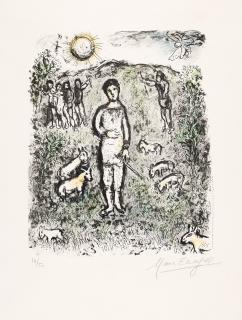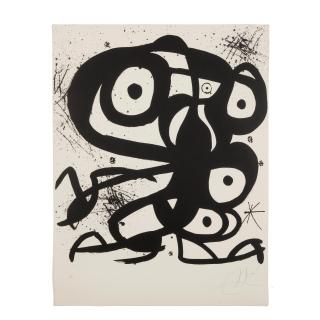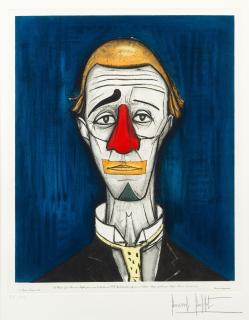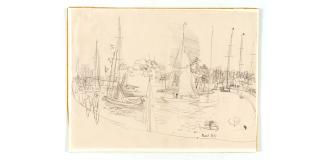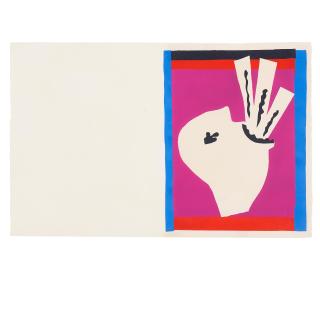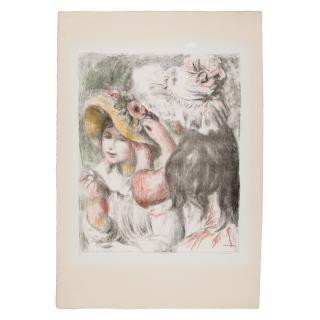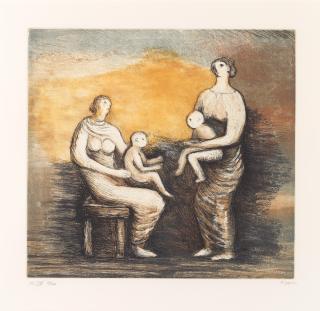Foujita Léonard Tsuguharu Foujita | France/Japan, 1886 - 1968
The artist Foujita
- The first to venture a mix of styles from traditional Japanese and contemporary European art.
- Best-known work: the frescoes in the Notre-Dame-de-la-Paix chapel in Reims.
- Took French citizenship and converted to the Catholic faith.
Foujita, born 27.11.1886 in Tokyo as Fujita Tsuguharu, deceased 29.01.1968 in Zurich, was a Japanese-French painter and graphic artist known for his mix of styles between traditional Japanese and contemporary European art. Characteristic of Foujita's work are his numerous portraits of young women as well as his self-portraits, in which he staged his striking appearance with a graphic pot cut, round glasses and a moustache.
Probably Foujita's most effective work of art to this day is the Notre-Dame-de-la-Paix Chapel in Reims, also known as the Foujita Chapel, which was built under the direction of the architect Maurice Clauzier. He decorated the chapel with frescoes depicting the life story of Jesus as well as events such as the atomic bombs dropped on Hiroshima. It was consecrated in 1966.
Foujita studied for three years at the Imperial Academy of Fine Arts in Tokyo. As early as 1910, he received awards for his work in Japan, so that even the then Tennō of Japan, Mutsuhito, acquired one of his paintings. During his journeys through France and England, he came into contact with contemporary European art for the first time.
In 1913, he moved to Paris and met artists such as Henri Matisse, Fernand Léger, Jean Cocteau, Juan Gris and Pablo Picasso and cultivated a close friendship with Modigliani. In 1913, he moved to Paris and met artists such as Henri Matisse, Fernand Léger, Jean Cocteau, Juan Gris and Pablo Picasso and cultivated a close friendship with Modigliani.
In 1917, he made his exhibition debut in Paris - showing works that featured his well-known mix of styles, including traditional Japanese and contemporary European art. He followed up this success in the next decade. His work was now recognised not only in Europe, but also in New York and Chicago in several exhibitions. From 1933 until the end of the war, he lived in his homeland, Japan, before returning to Paris. There he took French citizenship in 1950 and converted to the Catholic faith.
Foujita died in 1968 at the age of 81 from the consequences of his cancer and was eventually buried in the Notre-Dame-de-la-Paix under the fresco of the Resurrection of Jesus.
Der Künstler Foujita
- Wagte einen Stilmix aus traditioneller japanischer und zeitgenössischer europäischer Kunst.
- Bekanntestes Werk: die Fresken in der Kapelle Notre-Dame-de-la-Paix in Reims.
- Nahm die französische Staatsbürgerschaft an und konvertierte zum katholischen Glauben.
Foujita, geb. 27.11.1886 in Tokio als Fujita Tsuguharu, gest. 29.01.1968 in Zürich, war ein japanisch-französischer Maler und Grafiker, der für seinen Stilmix aus traditioneller japanischer und zeitgenössischer europäischer Kunst bekannt war. Kennzeichnend für Foujitas Arbeit sind seine zahlreichen Bildnisse junger Frauen sowie seine Selbstporträts, auf denen er sein markantes Äußeres mit grafischem Pottschnitt, runder Brille und Oberlippenbart inszenierte.
Das bis heute wohl wirksamste Kunstwerk Foujitas ist die Kapelle Notre-Dame-de-la-Paix in Reims, die auch als Foujita Chapel bezeichnet wird und die unter der Leitung des Architekten Maurice Clauzier erbaut wurde. Er verzierte die Kapelle mit Fresken, die sowohl die Lebensgeschichte Jesu als auch Ereignisse wie die Atombombenabwürfe auf Hiroshima thematisieren. Eingeweiht wurde sie 1966.
Foujita studierte drei Jahre an der Kaiserlichen Akademie der Schönen Künste in Tokio. Bereits 1910 erhielt er in Japan Auszeichnungen für seine Arbeiten, sodass sogar der damalige Tennō von Japan, Mutsuhito, ein Werk von ihm erwarb. Während seiner Reisen durch Frankreich und England kam er erstmalig mit zeitgenössischer europäischer Kunst in Berührung.
1913 zog er nach Paris und lernte namhafte Künstler wie Henri Matisse, Fernand Léger, Jean Cocteau, Juan Gris und Pablo Picasso kennen und pflegte eine enge Freundschaft zu Modigliani. 1917 konnte er sein Ausstellungsdebüt in Paris feiern – dort waren Werke zu sehen, auf denen sich sein bekannter Stilmix aus traditioneller japanischer und zeitgenössischer europäischer Kunst abzeichnete. An diesen Erfolg schloss er im kommenden Jahrzehnt an.
Seine Arbeit wurde nun nicht mehr nur in Europa, sondern auch in New York und Chicago mehrerer Ausstellungen gewürdigt. Von 1933 bis zum Kriegsende lebte er in seinem Heimatland Japan, ehe er wieder nach Paris zurückkehrte. Dort nahm er 1950 die französische Staatsbürgerschaft an und konvertierte zum katholischen Glauben.
Foujita starb 1968 im Alter von 81 Jahren an den Folgen seiner Krebserkrankung und wurde nach Umwegen in der Notre-Dame-de-la-Paix unter dem Fresko der Auferstehungsgeschichte beigesetzt.
Foujita in a nutshell
Foujita was a Japanese artist who spent much of his career in France, and his work reflects both his Japanese heritage and his exposure to Western art and culture. One of the things that makes Foujita's art special is his use of line and color. He was known for his delicate, precise line work, which he used to create highly detailed and intricate compositions. His use of color was also highly distinctive, with a palette that ranged from soft pastels to bold, vibrant hues.
He was known for his portraits of women, which combined traditional Japanese aesthetics with a modern, Western sensibility. His work is very popular in Japan, where he is considered one of the country's greatest artists, but it has also gained a following in the West for its unique style and universal themes.
Foujita moved to Paris in 1913 at the age of 26 to develop his artistic skills. Paris was the center of the art world and attracted many young artists from around the world. Foujita was fascinated by the modern European art movement and quickly made contact with the scene. He was particularly influenced by Impressionism and Post-Impressionism, but Foujita soon developed his own style.
This spelling is the original Japanese name of the artist, who was born Tsuguharu Fujita. It was not until he moved to Paris in 1913 that he adopted the French name Foujita.
Foujita is buried in the church of Notre-Dame-de-la-Paix in Reims, under the fresco of the Resurrection. The chapel was built in the 1960s and designed by Foujita, which is why it is also called the Foujita Chapel. It is the place Foujita intended for himself, but he was not buried there until 2003, 35 years after his death. He died in Zurich and was initially transferred to the chapel where his grave is now located. However, his wife Kimiyo had him moved to Villiers-le-Bâcle, where she lived.
Most of his works are in Tokyo, at the Artizon Museum and the Museum of Contemporary Art there. Another important place with over 100 works is the Hirano Masakichi Art Museum in Akita in northern Japan. Foujita's paintings can be seen in museums around the world, including the Centre Pompidou in Paris, the Museum of Modern Art in New York, and the National Gallery of Australia in Canberra.
Häufige Fragen zu Foujita
Foujita war ein japanischer Künstler, der einen großen Teil seiner Karriere in Frankreich verbracht hat. Sein Werk spiegelt sowohl sein japanisches Erbe als auch seine Auseinandersetzung mit der westlichen Kunst und Kultur wider. Foujitas Kunst zeichnet sich unter anderem durch seine Verwendung von Linien und Farben aus. Er war bekannt für seine feine, präzise Linienführung, mit der er sehr detaillierte und komplexe Kompositionen schuf. Auch seine Farbgebung war unverwechselbar und reichte von zarten Pastellfarben bis hin zu kräftigen, leuchtenden Tönen.
Er war bekannt für seine Frauenporträts, in denen er traditionelle japanische Ästhetik mit einer modernen, westlichen Sensibilität verband. Sein Werk ist in Japan sehr populär, wo er als einer der größten Künstler des Landes gilt, aber auch im Westen hat es aufgrund seines einzigartigen Stils und seiner universellen Themen eine große Anhängerschaft gefunden.
Foujita zog 1913 im Alter von 26 Jahren nach Paris, um seine künstlerischen Fähigkeiten weiterzuentwickeln. Paris war das Zentrum der Kunstwelt und zog viele junge Künstler aus der ganzen Welt an. Foujita war fasziniert von der modernen europäischen Kunstbewegung und fand schnell Kontakt zur Szene. Vor allem der Impressionismus und der Post-Impressionismus beeinflussten ihn, doch Foujita entwickelte bald seinen eigenen Stil.
Diese Schreibweise ist der ursprüngliche japanische Name des Künstlers, der als Tsuguharu Fujita geboren wurde. Erst als er 1913 nach Paris zog, nannte er sich französisiert Foujita.
Foujitas Grab befindet sich in der Kirche Notre-Dame-de-la-Paix in Reims unter dem Fresko der Auferstehung. Die Kapelle wurde in den 1960er Jahren erbaut und von Foujita entworfen, weshalb sie auch Foujita-Kapelle genannt wird. Es ist der Ort, den Foujita für sich selbst vorgesehen hatte, aber erst 2003, 35 Jahre nach seinem Tod, wurde er dort beigesetzt. Er starb in Zürich und wurde zunächst in die Kapelle überführt, wo sich heute sein Grab befindet. Seine Frau Kimiyo ließ ihn jedoch nach Villiers-le-Bâcle überführen, wo sie lebte.
Die meisten seiner Werke befinden sich in Tokio, im Artizon Museum und im dortigen Museum für zeitgenössische Kunst. Ein weiterer wichtiger Ort mit über 100 Werken ist das Hirano Masakichi Art Museum in Akita im Norden Japans. Foujitas Gemälde sind in Museen auf der ganzen Welt zu sehen, unter anderem im Centre Pompidou in Paris, im Museum of Modern Art in New York und in der National Gallery of Australia in Canberra.

